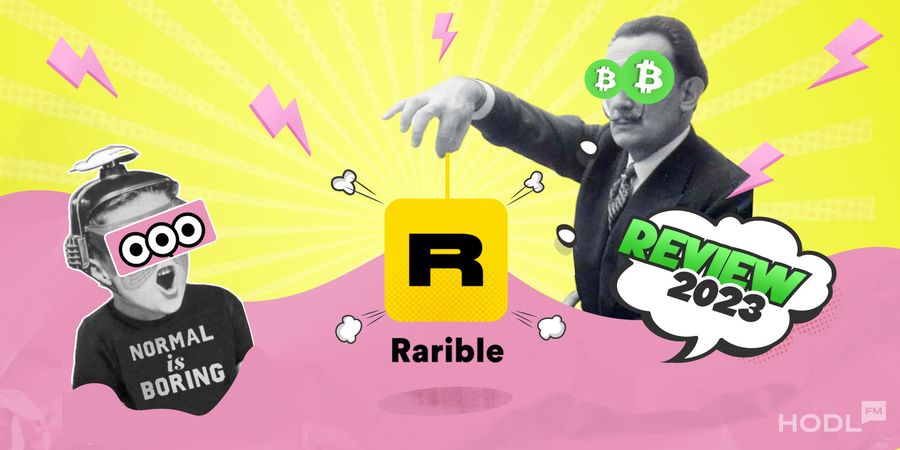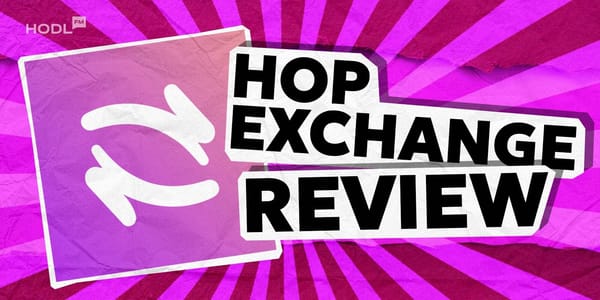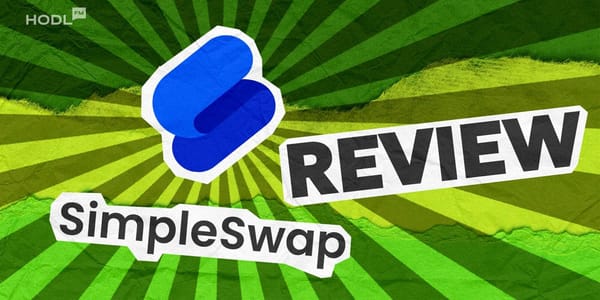- Rarible overview – What is Magic Eden?
- Rarible Alternatives
- Rarible pros and сons
- Rarible fees
- Rarible features
- Conclusion
- FAQs about Rarible
The wild west of blockchain-enabled realms: NFT (non-fungible tokens) marketplaces, where digital art can sell for millions, and even a tweet can be bought and owned. At the same time, entire NFT collections can be reduced to 0$ in no time. It is hard to tame the market, but some do it in style. To tame untamable NFTs and make a fortune out of flipping them, one must choose their marketplace right. This can be challenging given there is no shortage of marketplaces nowadays, but some stand out from the crowd.
One such platform that has gained significant popularity is Rarible. In this in-depth review, we’ll take a close look at Rarible, exploring its features, pros and cons, fees, and more. So buckle up and get ready to dive into the wild realm of Rarible in this article. Let’s get started!
What is Rarible?
If you’re venturing into the world of NFTs, Rarible is a marketplace that shouldn’t escape your radar. It’s a popular platform that caters to both seasoned collectors and newcomers to the NFT scene. Rarible offers a wide range of digital items, including art, gaming assets, metaverse creations, and more. It provides a user-friendly experience, allowing individuals to buy, sell, and even mint their own NFTs. Plus, it incorporates a unique governance model through its RARI token, enabling the community to have a say in the platform’s direction.
Read also: How to Monetize Your Digital Art with NFTs Guide
You can learn more about their governance model here. We would love to tell you more, but this article’s purpose is to have a broad overview of the platform, so, the technical stuff is off.
Marketplaces fighting for market share is a race to the bottom.
And it’s creators and collection owners who are:
🙅 not being heard
😰 losing royalties
👀 worried about future platform policiesWhat’s the solution? Community marketplaces on @rarible. 🧵👇 pic.twitter.com/wJhHkgsJnL
— Rarible (@rarible) March 3, 2023
Rarible functions as a versatile NFT marketplace operating across multiple blockchain networks. Users have the freedom to engage in buying, selling, trading, and creating NFTs within the platform’s compatible blockchains. With an array of NFT genres on display, Rarible presents itself as a user-friendly marketplace, particularly welcoming to aspiring creators eager to establish their presence in the NFT realm. By visiting the platform’s homepage and selecting the Explore tab, users can effortlessly switch between blockchains and delve into distinct NFT collections associated with each blockchain. Just with a click, or tap, you can switch blockchains. Big plus!
For collectors, Rarible provides the opportunity to mint their own NFTs using various cryptocurrencies and even offers the convenience of credit card payments for fixed-price items.
And a hidden gem: the platform includes a “dark” view mode, facilitating a visually comfortable experience for users as they explore and navigate its features.
Rarible Alternatives – A Battle of NFT Marketplaces
Before we delve further into the nitty-gritty of Rarible, let’s take a quick detour to explore some noteworthy alternatives in the NFT marketplace landscape. While Rarible has its own charm, it’s essential to consider other platforms that might better suit your preferences. Here’s a handy comparison table to give you a taste of what’s out there:
|
NFT Marketplace |
Trading Fees |
Supported Blockchains |
Notable Features |
|
Rarible |
2.5% |
Ethereum, Flow, Tezos, Polygon |
Easy-to-use platform, Multi-wallet connection, Gas-fee-free minting |
|
OpenSea |
2.5% |
Ethereum, Polygon, Klaytn |
Wide range of NFTs, High-profile security breaches |
|
Binance NFT |
1% |
Binance Smart Chain |
Lower trading fees, Regulatory challenges |
|
MagicEden |
2% |
Solana, Ethereum, Polygon, Bitcoin |
Intuitive interface and governance opportunities for users. |
|
SuperRare |
3% |
Ethereum |
The market features Spaces, which are independent galleries categorized by creator or collector interests. |
Sources of fees: OpenSea, Binance NFT, Rarible, SuperRare, MagicEden
Here are some more competitor info:
OpenSea
Opensea is a well-established NFT marketplace that offers a wide range of digital assets for buying, selling, and trading. It is known for its user-friendly interface and extensive selection of NFTs, attracting both experienced collectors and newcomers to the space.
SuperRare
SuperRare is a leading marketplace dedicated to rare digital art NFTs. Operating exclusively on Ethereum, it focuses on curating high-quality, limited-edition artworks, offering artists the opportunity to earn royalties on secondary sales.
Magic Eden
Magic Eden is a decentralized marketplace built on the Solana blockchain, providing a fast and cost-effective alternative to Ethereum. It aims to revolutionize NFT trading by offering an intuitive interface, community engagement, and governance opportunities for users.
Binance NFT
Binance NFT is a marketplace hosted on the Binance Smart Chain, offering a range of digital assets and collectibles. It distinguishes itself with lower trading fees compared to some other platforms and aims to provide a seamless experience for NFT enthusiasts. However, it has faced regulatory challenges in some jurisdictions.
Rarible Pros and Cons – Unveiling the Perks and Quirks
Are you a fan of making pros-cons list? In either case, you’ll find one below.
Now that we have a taste of Rarible’s competition, let’s focus on the platform itself and explore its pros and cons. Every marketplace has its strengths and weaknesses, and Rarible is no exception. So let’s take a closer look at what makes Rarible shine and where it falls short:
|
Pros |
Cons |
|
Easy-to-Use Platform: Rarible’s user interface is intuitive and beginner-friendly, making it easy for users to navigate and buy/sell NFTs. |
Some types of NFTs are not available: Rarible’s collection may be limited to certain categories such as domain names, sports collectibles, music, or videos. |
|
Supports several different blockchains: Rarible supports multiple blockchains, providing users with a wider range of options to buy, sell, and create NFTs. |
Poor anti-phishing measures: Rarible may lack explicit measures to combat phishing attempts, so users should be cautious and ensure the authenticity of transactions. |
|
Multi-wallet connection: Rarible allows users to connect up to 20 wallets to a single profile, making it convenient to manage multiple crypto assets. |
Limited educational material: While Rarible is beginner-friendly, it could benefit from providing more educational resources to assist new users in navigating the platform. |
|
Gas-fee-free minting: Rarible offers gas-fee-free minting, allowing creators to showcase their work without incurring high transaction fees. |
Key Features of Rarible
Rarible offers several noteworthy features that enhance the NFT trading experience. Here are a few key features that make Rarible a contender in the NFT marketplace landscape:
- Fractional Ownership
Rarible allows creators to offer fractional ownership of their NFTs. This enables investors to buy a fraction of an NFT, opening up opportunities for broader participation and reduced financial barriers.
- Blockchains Supported
Rarible stands out among other NFT marketplaces by supporting four different blockchains: Ethereum, Flow, Tezos, and Polygon. This enables users to avoid Ethereum’s high gas fees and access NFTs built on alternative networks. There are also rumors of Rarible adding support for Solana (SOL) in the near future.
- Wallet Compatibility
Rarible is compatible with major wallets such as MetaMask, Ledger, Rainbow, Coinbase, Fortmatic, Portis, and others. Users can connect nearly 20 different wallets to their Rarible profile, allowing them to conveniently manage and view all their NFTs in one place.
- Payment Methods
Rarible accepts payments in cryptocurrencies and credit cards. Regardless of the chosen payment method, a crypto wallet is required to transact on Rarible. The available cryptocurrency options align with the supported blockchains, allowing users to pay in ETH, FLOW, XTZ, or MATIC depending on the network.
For credit card payments, Rarible utilizes a third-party processor that converts fiat currency into the necessary crypto for purchasing NFTs. It’s important to note that credit card payments are subject to fees and have a minimum transaction threshold. Additionally, the third-party processor may have its own know-your-customer verification process.
- Royalties and Secondary Sales
We saved the superpower of Rarible for the last. In terms of creator royalties, Rarible offers remarkable flexibility. Creators can elect to receive up to 10% in royalties, while also having the option to assign custom royalties for multiple addresses, thereby expanding their potential revenue streams.
As a cutting-edge marketplace specifically catering to emerging talents in the NFT domain, Rarible stands as a reflection of the industry itself, characterized by wit, memes, and innovative storytelling. The platform’s diverse and engaging pool of NFT collections and creators embodies the dynamic and burgeoning world of web3.
Rarible Fees
As with any marketplace, fees play a crucial role in determining the overall cost of using Rarible. Here’s an overview of the key fees associated with Rarible:
|
Connection Fee |
When establishing a connection with Rarible, users are required to pay a nominal connection fee on the Ethereum network for their initial transaction, which is not collected by Rarible. |
|
Marketplace Fees |
The fee of 2.5% can be paid by the seller, or alternatively, if the seller opts not to cover it, the buyer is responsible for paying this fee upon purchase. |
|
Listing Fees |
2,5% |
|
Gas Fees |
While Rarible offers gas-fee-free minting, you’ll still need to consider gas fees when buying or selling NFTs. Gas fees vary depending on the blockchain you choose, and they can fluctuate based on network congestion. It’s essential to stay up to date with the current gas fees to avoid unexpected surprises. |
Conclusion
Rarible is a vibrant and user-friendly marketplace that offers a variety of NFTs across multiple blockchains. With its easy-to-use interface, multi-wallet support, and gas-fee-free minting, Rarible has positioned itself as a notable player in the NFT space. However, it’s not without its drawbacks, such as limited NFT categories. Well, nobody is perfect.
As an NFT enthusiast, it’s crucial to weigh the pros and cons, consider your specific needs and preferences, and explore other marketplaces before diving headfirst into Rarible.
FAQs about Rarible NFT Marketplace
How do I connect my wallet to Rarible?
Connecting your wallet to Rarible is a straightforward process. Simply click on the “Connect Wallet” button, choose your preferred wallet, and follow the on-screen instructions to complete the connection.
Can I mint my own NFTs on Rarible?
Absolutely! Rarible allows creators to mint their own NFTs on the platform. You can upload your artwork, set the desired parameters, and mint your NFT for the world to discover.
Can I sell my NFTs on Rarible for a fixed price?
Yes, Rarible offers the option to sell NFTs at a fixed price. You can set the price you deem appropriate for your NFT, and interested buyers can purchase it directly.
What is the RARI token, and how does it work?
The RARI token is Rarible’s native governance token. Holders of RARI have voting rights in the platform’s governance decisions, such as fee structure changes or feature implementations.
Are there any restrictions on who can buy NFTs on Rarible?
Rarible is accessible to users worldwide, but certain restrictions may apply based on the regulations of your country. It’s important to familiarize yourself with any legal obligations or restrictions before engaging in NFT trading.
Disclaimer: The information provided in this article is based on research and personal opinions, and it is subject to change. Always conduct your own research and exercise caution when participating in the NFT market.




